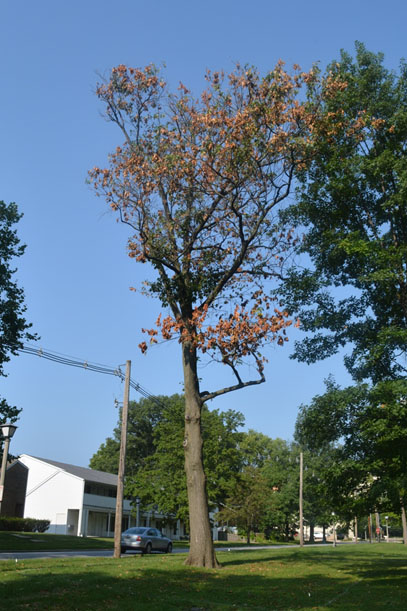Issue 12, July 26, 2016
Oak Wilt
The plant clinic has received several questions on Oak Wilt and recommended control strategies. Oak wilt is a devastating fungal disease that essentially plugs up the vascular system and disrupts the water and nutrient flow within oak trees. The disease progresses rapidly, killing mature trees in the red oak group within one season.

Oak Wilt Symptoms or Northern Red Oak.
Leaf symptoms vary depending on the oak species involved. Generally, species within the red oak group (pointed leaf lobes) develop discolored and wilted leaves at the top of the tree or at the tips of the lateral branches in late spring and early summer. The leaves curl slightly and turn a dull pale green, bronze, or tan, starting at the margins followed by a rapid defoliation. In some years, we have seen red oaks progress from scorched foliage to total defoliation in as little as 3 weeks.

Oak Wilt Symptoms or Northern Red Oak. Photo Credit: Nancy Pataky.
Species within the white oak group (rounded leaf lobes) show symptoms on scattered branches of the crown. The disease is often confused with general dieback and decline. Leaves on infected white oaks become light brown or straw-colored from the leaf tip toward the base. The leaves curl, but often remain attached to the branches. This tree group may die in one season but is much more likely to survive for many years with dieback and stressed appearance.
Accurate diagnosis and confirmation of the disease is essential. An incorrect diagnosis will often lead to the unnecessary removal of a tree as well as expensive treatments to protect nearby trees. A plant diagnostic laboratory can confirm or rule out the presence of oak wilt. The University of Illinois Plant Clinic receives an average of 50 oak wilt samples per year. Of those sampled, only a small number, 10-15 trees, are confirmed to have the disease. The samples not found to be infected with oak wilt either had symptoms that were caused by other less threatening pests and diseases or the test results were inconclusive due to poor sample quality (too dry, wrong portion of the tree sampled, not shipped correctly, etc.). Inconclusive results can be avoided by reviewing the tips and suggestions for oak wilt sampling provided within Issue 10 of the 2013 Home Yard and Garden Pest Newsletter.
There is no cure for oak wilt. Control strategies focus on preventing the disease from spreading to nearby healthy oaks. Oak wilt moves from diseased to healthy trees in two ways--through root grafts formed between trees and through fresh wounds via sap-feeding insects. Root grafts are common between oaks of the same species that are growing within close proximity of each other. All possible root grafts between healthy and infected trees should be severed mechanically before the diseased tree is removed. This can be accomplished by using a trenching machine or vibratory plow that will cut or break the roots to a depth of 3-5 feet.
Diseased and dead oaks should be removed as soon as possible. The use of diseased oaks for firewood is not recommended because the firewood is frequently not burned before the following spring. At that time, the diseased wood begins to produce fungal spore mats that attract insect vectors. If diseased wood is to be used, it should be debarked, cut to the proper length, split, stacked off of the ground, and protected from moisture in order to hasten drying. Firewood that has been debarked or stored in a dry place is not a source of infection.
Sap-feeding insects are responsible for the aboveground movement of the pathogen. The insects are attracted to fungal spore mats produced on trees killed during the previous year. Freshly wounded trees are also attractive to these spore contaminated insects. The wounds serve as an entry point for the pathogen. Wound infections are most likely to occur during the spring and early summer between the time the buds begin to swell and full leaf development. Pruning oak trees, especially oaks within the red oak group, should be avoided from April to October. The risk of this type of infection decreases by mid-July. However, those erring on the side of caution may choose to postpone any pruning until dormancy.
Finally, fungicide injections of propiconazole can be used to protect high value, healthy trees. If used, fungicides should be in combination with the strategies mentioned above. Therapeutic injections can also be effective on species within the white oak group when used early in the infection (less than 30% crown affected). Therapeutic injections are not recommended for infected trees within the red oak group.
For more information about oak wilt, consult Report on Plant Disease, no. 618, "Oak Wilt and Its Control" (Adobe PDF).
Examples of common oak pests and problems can be found within the Plant Clinic Report on Oak Problems. (Travis Cleveland)
Author:
Travis Cleveland